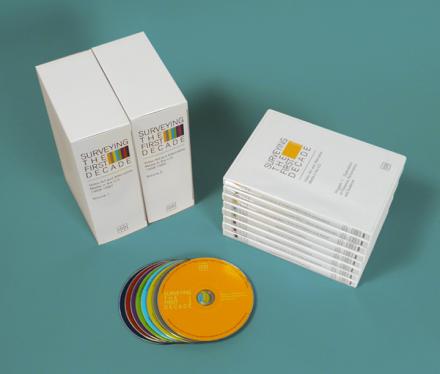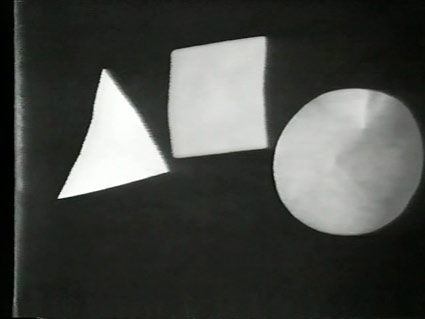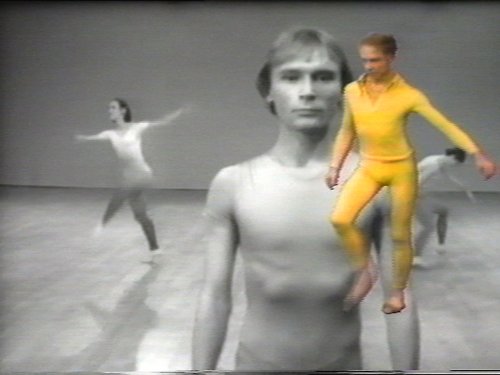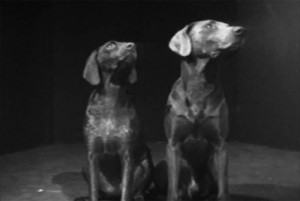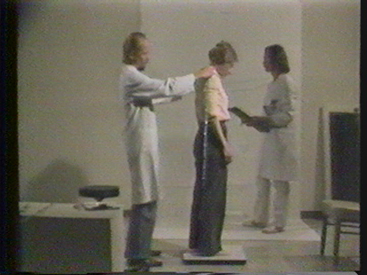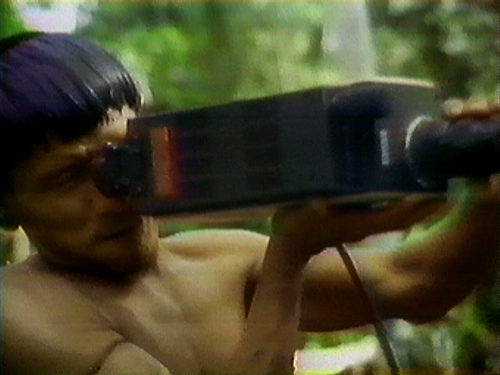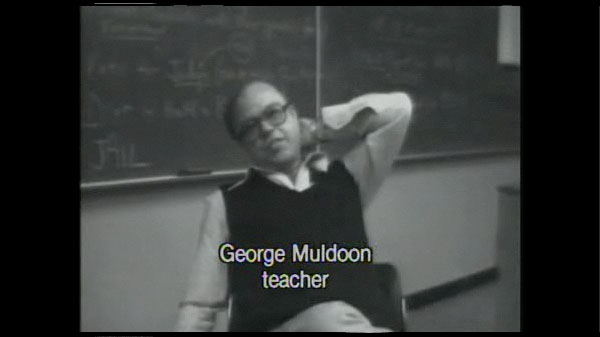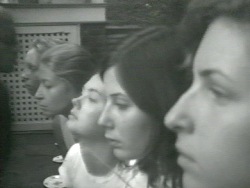From Moving Image Source (May 18, 2009). — J.R.
I wouldn’t say that video art per se makes me break out in hives. I even like some examples of it, including work by Thom Andersen, Gregg Bordowitz, Joan Braderman, Pedro Costa, Adam Curtis, Steve Fagin, Jean-Luc Godard (for me, his best work over nearly the past two decades), Ken Jacobs, Jia Zhangke, Abbas Kiarostami, Alexander Kluge, Mark Rappaport, Raúl Ruiz, Aleksandr Sokurov, Michael Snow, Leslie Thornton, and Bill Viola. But when it comes to most early American video art, I have an allergic reaction. A dozen years ago, while co-teaching a course with video artist Vanalyne Green at Chicago’s School of the Art Institute called “Film and Video: What’s the Difference?” I even tried -— without much sustained success — to combat this allergy homeopathically.
More recently, I’ve tried again by attempting to come to terms with the Video Data Bank’s multiregional DVD box set, Surveying the First Decade: Video Art and Alternative Media in the U.S. — a mammoth compilation curated by Christine Hill, encompassing eight discs, 68 titles, and over 16 hours, produced for institutional rather than consumerist use. (The cost is otherwise prohibitive: $1,350 before September 1, $1,500 afterward, and postage is extra.) And once again I’ve failed, though not without some edification and enlightenment along the way.
Hill’s program, first released in 1995, seems designed to capitalize on seeming dated and historical rather than contemporary in its address. (In a lecture-presentation given earlier this year in Chicago to preview the box set, her title was “Exercising the Archive: Looking Back at Looking Back.”) And the fact that so many of the tapes are excerpted rather than shown in their entirety — including, for instance, eight of the 17 selections in program no. 5, “Performance of Video-Imaging Tools” — only underlines how limited their interest often is as living art objects as opposed to academic conceptual exercises. If they’re supposed to be playing in some gallery space that I’m meant to walk around in and attend to only intermittently, there’s something torturous about sitting all the way through a good many of them on a DVD player, even as excerpts.
Here in program no. 5, the range of the work goes all the way from simply playing with the equipment (or what Woody Vasulka calls “dialogues with tools”) in several pieces to Dan Sandin’s demonstration of perceptual paradoxes (the inadequacies of both common language and conventional rules of perspective in relation to certain video-generated images) in his brief Triangle in Front of Square in Front of Circle in Front of Triangle (1973) to Nam June Paik’s seemingly exhaustive as well as exhausting combinations of Merce Cunningham’s dance with diverse kinds of video play in his rich, 27-minute Merce by Merce by Paik (1978). At its least engaging (Stephen Beck’s 1976 Video Weavings, mercifully reduced to only four minutes out of 28), this “performance of video-imaging tools” suggests something like op-art animation accompanied by elevator music. And when the notes accompanying William Wegman’s silent, Selected Works (Dog Duet, Used Car Salesman, Dog Biscuit in Glass Jar) (1972) in program no. 1 — performance pieces of Wegman and his dog — claim that the dog’s “pursuit of a dog biscuit inside a glass bottle creates the type of narrative suspense that draws us into the action,” I start to become skeptical. (It’s apparent to me, if not to the dog, that he’s never going to be able to retrieve the biscuit unless he breaks the bottle, as he eventually does.)
I should hasten to add that this anthology is devoted to “alternative media” as well as to video art, just as its title says, meaning that roughly half of its focus is on social and political documentation in which video simply becomes the nearest tool available. Sometimes this yields a rather confusing marriage of convenience in which dry gallery formalism and sweaty political activism are made to rub shoulders, as if they belonged in the same box set for any other reason except by default. Both kinds of video have their legitimacy, but whether they belong together in this fashion is open to debate.
This is a debate, however, that this collection consciously stages. Roughly speaking, programs no. 1 (“Explorations of Presence, Performance, and Audience”), and no. 2 (“Investigations of the Phenomenal World—Space, Sound, and Light”), most of no. 3 (“Approaching Narrative — ‘There are problems to be Solved’ ”), and no. 5 are chiefly formal, whereas programs no. 4 (“Gendered Confrontations”), no. 6 (“Decentralized Communications Projects”), no. 7 (“Critiques of Art and Media as Commodity and Spectacle”), and no. 8 (“Independents Address TV Audiences”) are chiefly sociopolitical. But even this division oversimplifies some of the groupings: Martha Rosler’s Vital Statistics of a Citizen, Simply Obtained (1977) in no. 4 qualifies as angry agitprop, but it’s also highly formal in its strategies, and Juan Downey’s The Laughing Alligator (1979) in no. 6, a personal ethnographic diary taped while Downey and his family were living among the Yanomami people of Venezuela, shows as much formal intelligence as his 1986 J.S. Bach (not included in this box set). Furthermore, the pioneering video artists Steina and Woody Vasulka — represented by four works, including ones made separately by each of them—also manage to straddle both categories, with three formal studies in no. 5 and one in no. 2 (Participation) that records a couple of concert performances — a terrific rhythm-and-blues singer at the Fillmore East and a stumbling off-Broadway drag queen.
Consider also the two programs among the eight consisting of only three works apiece, no. 3 and no. 8. It may oversimplify matters even to say that no. 3 is devoted chiefly to form, because the final work excerpted here — Arthur Ginsberg and Video Free America’s The Continuing Story of Carel and Fred (1972-75) — seems as content-driven (with performance as the main content) as the John Waters features made during the same era, Pink Flamingos and Female Trouble. This video attempts to chronicle the marriage of filmmaker/porn star Carel Rowe and bisexual junkie Ferd Eggan over a couple of years and then have them comment on their relationship and their footage.
And if I wind up feeling drawn more toward the content of the first two items in no. 8 than toward anything else in these two volumes, this is because they offer so much to chew on. Healthcare: Your Money or Your Life, produced by the founders of the Downtown Community Television Center and taped at two medical facilities in Brooklyn across the street from one another — the underfunded, overbooked, city-run Kings County Hospital and the sleek, private Downstate Medical Center — was made 32 years ago, but the brutal class disparities it exposes couldn’t be more up to date. Shot in Mill Valley, California, two years later, Peter Bull and Alex Gibney’s fascinating The Ruling Classroom (1979-80) explores a seventh-grade experiment in which students constructed their own imaginary country with its own government, constitution, newspaper, and fines, and also — one eventually discovers with some dismay — its own litigation, theft, and libel. Both of these works are important documents that would be welcome under any circumstances, and the same could be said of such public-access marvels as Queen Mother Moore describing the lynching of her grandfather in a 1973 speech at Greenhaven Prison, in program no. 5.
But turning from these works to the formal/conceptual exercises of Vito Acconci in The Red Tapes Part II and Richard Foreman’s Out of the Body Travel in program no. 3, I suddenly find myself trapped inside them like a rat caught in a lab experiment. The first of these juxtaposes Acconci’s offscreen diary musings with various explorations or displays of his own installations, toys, playing cards, and body parts, calling to mind Rosalind Krauss’s celebrated essay of the same year “Video: The Aesthetics of Narcissism”: “Self-encapsulation — the body or psyche as its own surround — is everywhere to be found in the corpus of video art.” The second, with some ponderous offscreen narration of its own, recasts the kind of formal tableaux found in Foreman’s theater work of the same period. Here there’s more visual interest thanks to the claustrophobic compositions (the gifted cinematographer Babette Mangolte shot this), but I still can’t find any sustaining intellectual challenges or poetic stimulation here, and the rough surface of the 1976 black-and-white video seems to rule out the possibility of much sensual pleasure. Yet “seems to” is the operative term here. A year later, in his nine-minute Sweet Light (included in program no. 2), Bill Viola offers all the sumptuous surfaces that anyone could ask for and makes them all the more inviting by locating them in the everyday experience of light.
Part of the basic problem for me is that video isn’t simply a retooling of film by cruder means but an art form with a different aesthetic. And though this is rarely discussed, the different aesthetics might have some relation to the different aesthetics of live TV drama and Hollywood filmmaking during the 1950s — even though I can respond nowadays to the remnants of live TV drama with less difficulty. Watching the partially improvised mise en scène of Franklin Schaffner in Twelve Angry Men (1954) or of John Frankenheimer in The Comedian (1957), even long after they’re no longer live, is not unlike following the unpredictable solos of a gifted jazz musician in which the calculated risks and even the occasional fluffs become part of the overall aesthetic experience. Although the intricate moves of the cameras and actors in these live dramas were often rehearsed for weeks, the volatility of the performances and the necessity in some cases of leaping from one set to another made for an overall approximation in the framing and an unpredictability in the deliveries that registered at times like wild gambles taken by very canny players. This is distinctly different from the more calibrated and calculated mise en scène of Kubrick (Paths of Glory) or Welles (Touch of Evil) during the same period, which is less rough and approximate in terms of precise framings and also less volatile in following the whims of the moment — just as the acting on live TV, much closer to what transpires on a stage, is broader and more declamatory.
This distinction seems confirmed by Viola’s point in a 1981 essay, “The Porcupine and the Car” (included in his 1995 collection Reasons for Knocking at an Empty House): “One of the most fascinating aspects of video’s technical evolution, and the one that makes it most different from film, is that the video image existed for many years before a way was developed to record it. In other words, it is live, simultaneous with experience. Taping or recording is not an integral part of the system. Film is not film unless it is filming (recording). Video, however, is `videoing’ all the time, continually in motion, putting out 30 frames, or images, a second. (In Europe this is 25 frames, due to differences in AC power cycles.)”
To complicate matters, there are also works included in this package whose aesthetics dovetail into those of film while remaining videos that are medium-specific. In her almost 20-minute, black-and-white Vertical Roll (1972), Joan Jonas performs a belly dance (under the guise of her “alter ego,” Organic Honey) while the video frame around her continues to roll, so that some of the perceptual challenges of structural film (as in Michael Snow’s 1969 Back and Forth and his 1971 La Région Centrale) are placed in direct conflict with a voyeuristic invitation. Both the challenges and the invitation could be called filmic, but the technique employed is wholly that of video.
All this implies that, in the final analysis, video, even when it’s restricted to the early works produced in a single country, is still such a large and unwieldy category that any anthology attempting to encompass it comprehensively is bound to confound as well as suggest various kinds of theorization. This makes Surveying the First Decade: Video Art and Alternative Media in the U.S. an invaluable teaching tool even when — and sometimes even because — it tries one’s patience

